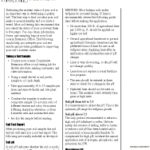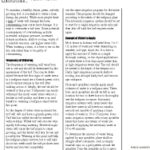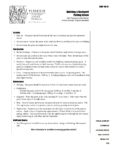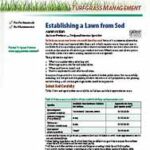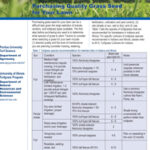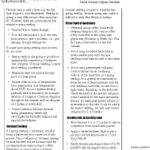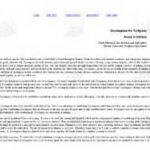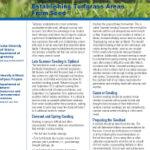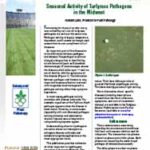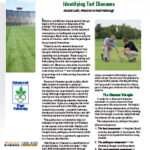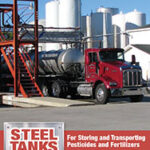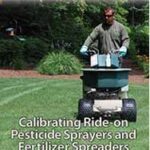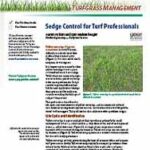Extension Publications
Mowing, Thatching, Aerifying, and Rolling Turf (AY-8-W)
Purdue Extension Publication
A publication that gives suggestions for maintaining turf by effective mowing, thatching and aerifying.
Turfgrass Weed Control for Professionals (TURF-100)
Purdue Extension Publication
This guide provides weed identification and control information that turfgrass professionals can use to develop effective weed control programs for golf courses, athletic fields, sod farms, lawns, and other turfgrass systems. The recommendations apply to the majority of the United States, with input from experts in Illinois, Indiana, Iowa, Kansas, Kentucky, Maryland, Michigan, Minnesota, Missouri, […]
Building a Backyard Putting Green (AGRY-98-01)
Purdue Extension Publication
Location Full sun – The green should be located in full sun for optimum turf growth and performance. Air movement – Locate the green so the wind (air flow) is not blocked by trees or buildings. Do not locate the green in a depression or low area. Construction Surface drainage – Contours on the green […]
Purchasing Quality Grass Seed for Your Lawn (AY-25-W)
Purdue Extension Publication
This publication provides help when selecting turfgrass for different lawns. Things to look for on a bag of quality grass seed are also covered. It also defines key terms that are used with planting and maintaining turfgrasses.
Seeding a Turf Area in the Spring (AY-20-W)
Purdue Extension Publication
This publication provides turf seeding guidelines in the spring for established turf areas and new turf areas.
Zoysiagrass for Indiana (AY-6-W)
Purdue Extension Publication
This publication provides suggestions on establishing and maintaining midwestern lawns composed of zoysia and bermuda grass.
Turfgrass Insects: Managing White Grubs in Turfgrass (E-271-W)
Purdue Extension Publication
This publication provides Indiana turfgrass management professionals and property owners with information to help them (1) properly identify the most common white grub species, (2) understand white grub biology, (3) recognize white grub damage, and (4) formulate safe and effective management strategies.
Turfgrass Disease Profiles: Seasonal Activity of Turfgrass Pathogens (BP-125-W)
Purdue Extension Publication
Understanding when turf pathogens are active allows turf managers to anticipate disease outbreaks and schedule fungicide applications at the most appropriate times. This publication provides estimates of when important turf pathogens are active in the lower Midwest.
Turfgrass Disease Profiles: Turf Disease Identification (BP-124-W)
Purdue Extension Publication
This publication will help turf managers know what to look for when they diagnose infectious turf diseases on the course and in the field. Readers will understand the components of the disease triangle (host, pathogen, and environment), and then be able to use that concept to develop a systematic approach identifying turf disease.
Adjuvants and the Power of the Spray Droplet: Improving the Performance of Pesticide Applications (PPP-107)
Purdue Extension Publication
This publication examines how the various components of a pesticide application work (water, pesticide molecules, application equipment). It then describes how adjuvants can enhance pesticide performance and protect against the unwanted consequences of spray drift. The goal is to define what adjuvants do and highlight their value in improving pesticide applications.
Steel Tanks for Storing and Transporting Pesticides and Fertilizers (PPP-105)
Purdue Extension Publication
This publication explores the aspects of purchasing and using mild steel and stainless steel tanks for farms, businesses, and public agencies. It provides important questions you should ask before you buy, offers tips to properly install tanks, and establishes guidelines for inspection and maintenance.
Calibrating Ride-on Pesticide Sprayers and Fertilizer Spreaders: Keys to Application Accuracy (PPP-104)
Purdue Extension Publication
This publication addresses specific procedures for separately calibrating the pesticide sprayer and the fertilizer spreader of ride-on equipment. The goal is to ensure proper application to optimize performance.
Turfgrass Management: Sedge Control for Turf Professionals (AY-338-W)
Purdue Extension Publication
This publication describes the life cycle and identification of yellow nutsedge, and recommends cultural and chemical management options in cool- and warm-season turf for professional turf managers. This publication also addresses other problem sedges. A similar publication is available for homeowners: Turfgrass Management Yellow Nutsedge Control (AY-19-W)
